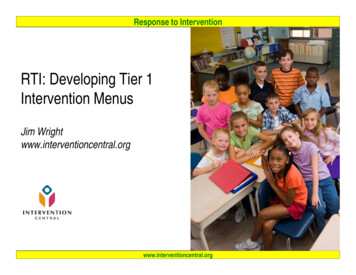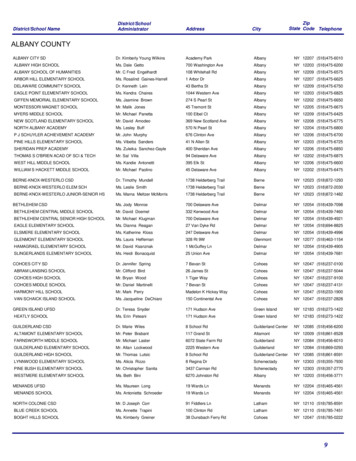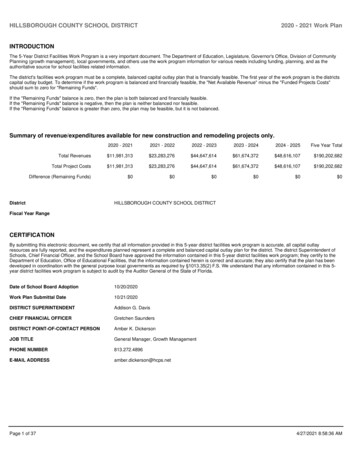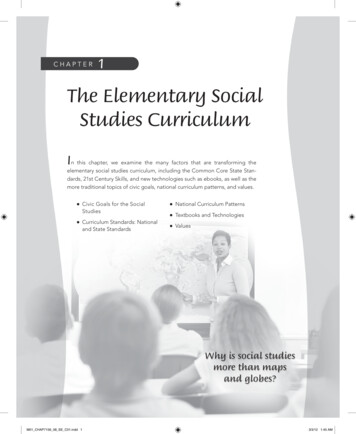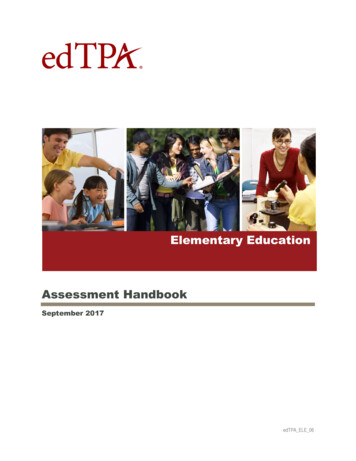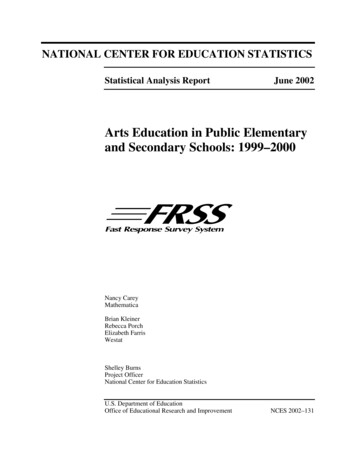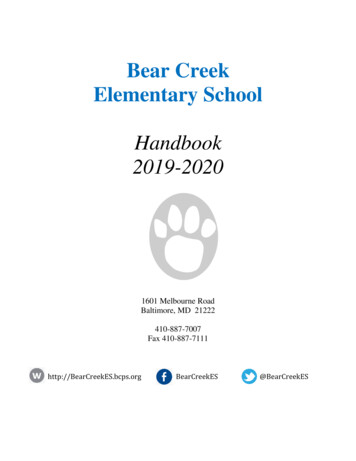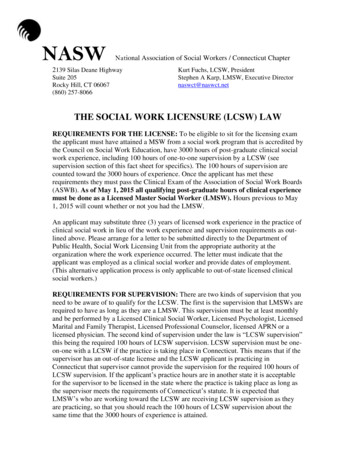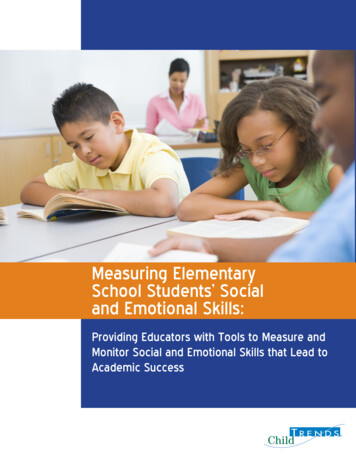
Transcription
Measuring ElementarySchool Students’ Socialand Emotional Skills:Providing Educators with Tools to Measure andMonitor Social and Emotional Skills that Lead toAcademic Success
Measuring Elementary School Students’Social and Emotional SkillsProviding Educators with Tools to Measure and Monitor Social andEmotional Skills that Lead to Academic SuccessChild TrendsJuly 2014
ContentsIntroduction . 1Background: Five Key Social and Emotional Skills . 4Measuring Social and Emotional Skills. 5Measures Review . 6Identification and Adaptation of Survey Questions . 10Expert Feedback . 11Investee/Teacher Feedback . 12Pilot Data . 13Finalizing the Survey. 13Final Measurement Tool . 14Teacher Survey . 15Student Survey . 15Data Entry and Analysis . 16Conclusion . 16References . 19Appendices. 22Appendix A: Psychometric Analyses of Pilot Survey . 23Appendix B: Teacher Survey. 26Appendix C: Student Survey . 29Appendix D: Operationalization Document . 34Appendix E: Scoring Guide . 38Child Trends Publication #2014-37
Introduction“When paradigms change, the world itself changes with them.” – Thomas KuhnA Growing Need in Education. Mounting evidence from the field’s research points to social andemotional skills as playing a central role in shaping student achievement, workplace readiness,and adult wellbeing (See, Chien, Harbin et al. 2012; Delale-O'Connor, Farley et al. 2012;Guzman, Caal et al. 2014). In the last 20 years, volumes of research have been publisheddocumenting and quantifying the importance of social and emotional learning in creating betteroutcomes for children. More and more, schools and youth-serving organizations are seekingways to effectively integrate social and emotional learning into their classrooms and programs.But as of yet, the development of consistent standards, measures, and tools to support schoolsand organizations in measuring and monitoring these skills remains a need in the field.Tauck Family Foundation’s New Mission. In 2012, the Tauck Family Foundation adopted a newmission that seeks to address this need:to invest in the development of social and emotional skills that lead to better prospectsfor children from low-income families in Bridgeport, Connecticut.Specifically, the Foundation seeks to focus on skills that research shows are malleable (can betaught and learned) and will help students manage their emotions and behaviors effectively,persist toward their goals, value learning for its own sake, effectively interact and cooperatewith others, and believe that they are capable of achieving academically. By investing in a smallgroup of non-profits that are working with elementary school students in Bridgeport, theFoundation hopes to build its investees’ capacity to do performance management and use datato inform teacher practice for continuous improvement purposes. For more information on theFoundation’s strategy and Theory of Change, please see www.tauckfamilyfoundation.org.This report describes the rigorous, collaborative work undertaken by the Tauck FamilyFoundation and Child Trends, a national leader in measuring children’s development and wellbeing, and provides the results of that work. Child Trends’ and the Foundation’s primary goalwas to create tools that the Foundation’s investees could use to assess and monitor the extentto which the organizations are improving low-income students’ social and emotional skillsassociated with success in school and life. A secondary goal was to provide these tools andrelated guidance to other educators across the country who share a desire to strengthenstudents’ social and emotional skills as a strategy for supporting their success.New Paradigm. In adopting a new mission and Theory of Change, the Foundation acknowledgedthe promise of social and emotional skills for creating better outcomes for children.Measuring Elementary School Students’ Social and Emotional Skills 1
Social and emotional skills include a broad set ofcompetencies. While it would be ideal to focus onall of them, it is not necessarily feasible for a singleprogram or school to do so. Aware of theconstraints on schools and other academicprograms, the Foundation commissioned ChildTrends to narrow the field of possibilities to aspecific set of skills that schools or academicprograms could reasonably focus on to increasestudent achievement (see Figure 1). Child Trendsconducted a systematic literature review ofdifferent social and emotional skills. This originalreview identified approximately 15 different skillslinked to academic and/or future adult success,such as self-control, responsibility, attentiveness,prosocial behavior, and mastery orientation. ChildTrends further narrowed the list of skills to thosewhich the literature suggested were: based on strong research that the skills leadto better long-term prospects for students,particularly malleable or can be taught anddeveloped,empowering for children,appropriate for elementary-aged children tolearn, andmutually reinforcing.Based on these criteria, Child Trendsrecommended that the Foundation focus on selfcontrol, persistence, mastery orientation, andacademic self-efficacy.To highlight the malleability of each skill, ChildTrends also identified a small number of specificstrategies for illustrative purposes that could be used to encourage the development of each ofthe skills. For example, teaching students coping strategies to deal with failure and setbacks isone way that educators can build students’ abilities to persist. Another example is that helpingstudents set goals and engage in self assessment can foster students’ academic self-efficacy.Notably, while each of the selected skills is distinct and has their own hallmark characteristics,they also relate to and reinforce each other. For example, students who can regulate theiremotions and impulses are better able to persist in the face of challenges. Similarly, persistencemay reinforce mastery orientation as the student focuses on working to successfully completechallenging tasks to master the work. Finally, in completing these challenging tasks, studentsgain in academic self-efficacy.Measuring Elementary School Students’ Social and Emotional Skills 2
After consulting with other experts in the field of social and emotional learning, the Foundationsought Child Trends’ feedback about adding a social component to the set of identified skills.Child Trends’ understanding of the research literature corroborated the Foundation’ssuggestion to include social competence to the suite of skills. Education is a social endeavorwith successful students having the ability to get along with their peers and teachers. Like theother skills, social competence is malleable. For example, strategically grouping students andsetting classroom expectations can support students’ abilities to successfully work with theirpeers. Additionally, social competence aligns well with self-control since students who are ableto regulate their emotions tend to be able to cooperate more with others.Through this iterative, collaborative process with Child Trends, the Foundation is adding tothe field of social and emotional skill development in academic environments by helpingschools and other programs focus their efforts on a limited suite of skills. In addition tospecifying these social and emotional skills, the Foundation is also testing new methods oftracking and improving the quality of how schools and programs develop them.New Measures. In addition to identifying and selecting five key social and emotional skills thatimprove students’ outcomes, the Tauck Family Foundation is committed to helping investeesbuild their data collection and measurement infrastructure to assess these skills. As part of thiscommitment, the Foundation partnered with Child Trends to develop tools to measure theseskills.Drawing on previously validated tools and in consultation with the Foundation and itsinvestees, including teachers and experts from the field, Child Trends developed a teacher andstudent survey addressing these five skills. These surveys can be used as formative assessmenttools to track the progress of individual students within a single academic/program year. Theycan also reinforce and verify data from daily/weekly reports of student behaviors that might becollected in a performance management context. Aggregated data from these surveys can alsohighlight changes in whole classrooms and programs. A unique aspect of these surveys fromothers in the field is their ability to track short-term outcomes so that teachers/programadministrators can make data-driven adjustments in their practices to build these social andemotional skills.This paper highlights the research on the importance of five skills to academic success,summarizes the iterative process used to develop a measurement tool to assess these skills,and suggests two options for incorporating the measurement of these skills in regularclassroom data collection. The intent of this work is to provide teachers and programs with datathey can use to gauge and improve student social and emotional competencies in areas thatmatter for students’ success in school and beyond. While the measurement tools describedwere designed specifically for the Foundation’s investees, they may be appropriate to use inother settings with programs targeting similar social and emotional skills as outcomes.Suggestions and caveats for use are covered in section titled “Final Measurement Tool.”Measuring Elementary School Students’ Social and Emotional Skills 3
Background: Five Key Social and Emotional SkillsAs described above, a series of reviews1 of the existing research studies revealed fivecompetencies and skills that help students excel in school over time: self-control, persistence,mastery orientation, academic self-efficacy, and social competence. While they are strong as acollective (as indicated above), each skill taps into distinct areas of students’ abilities anduniquely affects student achievement, as described below.Self-control refers to the ability to manage or regulate emotion and behaviors, inhibit negativeresponses, and delay gratification in ways considered socially appropriate for a given situation(Bandy and Moore 2010). Having self-control enables children to focus and stay on task. In fact,researchers have argued that self-control is as important for academic success as intelligence(Blair 2002). Research has also found that self-control in childhood is associated with academicand social competence, verbal fluency, healthier and more productive behaviors (e.g., avoidingsubstance use and teen pregnancy, spending more time doing homework), and the ability tocope successfully with frustration and stress later in adolescence (Mischel, Shoda et al. 1988;Tangney, Baumeister et al. 2004; Duckworth and Seligman 2005; Moffitt, Arseneault et al.2011).Some researchers have defined persistence in children as the “voluntary continuation of a goaldirected action in spite of obstacles, difficulties, or discouragement” (Peterson and Seligman2004). The term grit is also used in some instances to describe “perseverance and passion forlong-term goals” (Duckworth, Peterson et al. 2007). Whichever term is used, the underlyingconcept focuses on a child’s attitude and determination to continue at a task or to work at agoal over an extended period of time—despite challenges or failures that may occur along theway. Children with high levels of persistence tend to be less anxious and are more likely toattempt solutions to difficult problems when compared with peers who exhibit lower levels ofpersistence (Lufi and Cohen 1987). Similarly, research shows that college students with higherlevels of grit tend to study more, to have higher grade-point averages, and to watch fewerhours of television than do students with lower levels of grit (Duckworth, Peterson et al. 2007).Mastery orientation is an approach to learning in which a child pursues learning because he orshe wants to increase his or her overall competence or abilities over time until something ismastered. This concept is frequently contrasted with a performance orientation, the act ofpursuing learning in order to obtain positive feedback from others on his or her competence(Wolters 2004; Delale-O'Connor, Farley et al. 2012). Research shows that children with thisorientation tend to procrastinate less, to use more effective learning strategies, and to achievehigher science grades than do children with a performance orientation (Meece and Holt 1993;Wolters 2004). In addition, children with mastery orientation tend to believe that intelligence ismore malleable, that is, that through their efforts they can improve (Dweck and Leggett 1988).Perhaps reflecting this belief, they earn higher grades and achieve higher test scores (Stipek andGralinksi 1996) than do children who believe that intelligence is fixed and cannot be improved.Additional studies have found that the positive effect of mastery orientation on academicperformance can continue for several years (Blackwell, Trzesniewski et al. 2007).1Earlier working papers and memos Child Trends prepared for the Foundation provide a more detailed literature review (Chien,Harbin et al 2013; Delale-O’Connor, Farley et al. 2012; Guzman, Caal et al. 2014). These are available online or upon request.Measuring Elementary School Students’ Social and Emotional Skills 4
Academic self-efficacy refers to a person’s belief that he or she can perform a variety ofacademic tasks effectively, while general self-efficacy refers to the belief in one’s ability toaccomplish any task, along with the understanding that the actions one takes will influence atask’s outcome (Zimmerman 1989; Liew, McTigue et al. 2008). This belief influences the effortput into academic work, as well as continued persistence and resilience when faced withchallenges (Zimmerman 1989; Liew, McTigue et al. 2008). An individual’s academic self-efficacyis believed to be linked to the individual’s thought patterns, emotional responses, and —ultimately— to his or her academic success (Zimmerman 1989; Liew, McTigue et al. 2008). Priorresearch has found that children with high levels of academic self-efficacy use more effectivelearning strategies and frequently achieve higher levels of literacy and math achievement thando children with low academic self-efficacy (Zimmerman 1989; Liew, McTigue et al. 2008).Social competence refers to a broad set of skills necessary to get along with others and behaveconstructively in groups (Rose-Krasnor 1997; Smith and Hart 2004). For the purposes of thiswork, we defined social competence as a student’s ability to: 1) take others’ perspectives, 2)work well with peers to accomplish a task, 3) resolve problems in ways that maximize positiveconsequences and minimize negative consequences for the student and her/his peers, and 4)behave appropriately according to the situation and social norms. Although social competenceis linked with the other skills described above, it contributes uniquely to academic success byaddressing the inherently social dimensions that are characteristic of learning in a classroomsetting (Ladd, Herald et al. 2006). Social competence helps students interact constructively withpeers, teachers, and other school officials and shapes their feelings of connection to the school,thus indirectly improving academic competence (Smith and Hart 2004; Ladd, Herald et al. 2006;Valiente, Lemery-Chalfant et al. 2007).Measuring Social and Emotional SkillsAs noted earlier, the Tauck Family Foundation and Child Trends worked closely to develop toolsto measure the identified social and emotionalskills. This iterative process (see Figure 2)included: 1) a measures review; 2)identification and adaptation of draftquestions; 3) feedback from experts; 4)feedback from Foundation investees, includingteachers; 5) piloting the tools with one of theFoundation’s investees; and (6) analyzing thequalitative and quantitative data to revise theinstrument. To view the evolution of the surveyquestions from their use in the literature totheir use in the surveys developed for theFoundation’s grantees, see the companiondocument, “Measures Development Resource:Source Table for Original Items Used in theTauck Family Foundation FormativeAssessment Tools.”Measuring Elementary School Students’ Social and Emotional Skills 5
Measures ReviewChild Trends reviewed tools that researchers have used to measure each of the five social andemotional skills. Child Trends was particularly interested in measurement approaches that hador could be used with the population served by the Foundation’s investees: children from lowincome families in K-5th grade. Additionally, Child Trends was interested in approaches thatcould be applied on an ongoing basis in a classroom/program setting. These skills have beenmeasured in a variety of ways, including observations, peer ratings, laboratory tests, reportsfrom individuals about their own behaviors, and reports from parents and/or teachers. Each ofthese measurement approaches has both advantages and disadvantages. This section describeshow each social and emotional skill has been measured in the past based on the literature.Self-ControlPrior attempts to measure self-control in young children have included parent and teacherobservations along with the use of a series of tests or activities completed by children(Newman, Noel et al. 1998; Normandeau and Guay 1998). Perhaps the most well-knownmethod for measuring self-control among children is the “marshmallow test,” which wasoriginally conducted in 1972. For the original marshmallow test, children received a singlemarshmallow and were told that if they could wait 15 minutes without eating themarshmallow, they would receive a second marshmallow, at which time they could eat both.Researchers timed how long each child waited before eating the marshmallow (Mischel,Ebbesen et al. 1972). Periodic observations, usually conducted by a child’s teacher or parent,provide an additional method to measure self-control, and have been used successfully in pastresearch studies to measure changes over time among children (Liew, McTigue et al. 2008).While these types of tests or activities can provide accurate measures of self-control and maypredict later outcomes, they have several limitations. First, they are resource intensive andrequire that an adult be available to oversee the test and time each child’s response.Additionally, they are not designed to be administered repeatedly to assess change over time.They probably would not be feasible for the Foundation’s investees to use to measure selfcontrol in students, since these approaches are resource intensive and would be difficult toadminister for a large number of children.Other researchers have used teacher, parent, and student surveys to measure self-control inelementary school-age children. For example, the Self Control Rating Scale has been used toassess children’s self-control through reports from teachers and parents (Kendall and Wilcox1979), whereas the Child Self Control Rating Scale was developed and tested as a way for olderelementary school children (3rd and 5th graders) to report about their own ability or lack ofability with self-control (Rorhbeck, Azar et al. 1991). Surveys can be used to repeatedly assesschanges over time and require less resources than formal observations; however, a keychallenge is that they are often long, many containing upwards of 30 distinct questions (Kendalland Wilcox 1979; Rorhbeck, Azar et al. 1991; Causey and Dubow 1992; Canivez, Willenborg etal. 2006). For the Foundation’s investees, teacher and student surveys with fewer questionswould be more appropriate. Child Trends recommended that Foundation investees measure self-controlthrough a teacher survey and a student survey.Measuring Elementary School Students’ Social and Emotional Skills 6
PersistencePersistence has been measured in previous studies primarily through the administration of aseries of activities or tasks, or through the use of surveys (Lufi and Cohen 1987; Duckworth,Peterson et al. 2007; Duckworth and Quinn 2009). The most commonly used approach tomeasure persistence among elementary school-age children is to have them work onprogressively more challenging tests or activities and see whether or not they continue to workthrough challenges (Lufi and Cohen 1987; Duckworth, Peterson et al. 2007; Duckworth andQuinn 2009). Although this approach can be successful in measuring persistence, these testsare time-consuming and are not designed to be administered to children repeatedly or toassess changes in levels of persistence over time.Student survey questions for persistence offer a more viable option for programs (such as theFoundation’s investees) to measure this skill. However, self-report surveys to measurepersistence are frequently long, contain many questions, and are primarily intended for usewith teenagers and young adults (Lufi and Cohen 1987). A survey to measure grit amongyounger populations (Short Grit Scale) has been developed and tested on youth between theages of 10 and 15 (i.e., 4th-9th graders) and found to be effective (Duckworth and Quinn 2009).Butler-Barnes et al (2013) have measured academic persistence among African American 7th-9thgraders using an adapted version of the Scale for Academic Engagement, and Piazza and Siebert(2008) have developed and tested a survey to measure persistence as it relates to writing tasksamong 4th-6th graders.The literature also suggests that teacher surveys would also be an appropriate means forFoundation investees to measure persistence. Previous studies have accurately measuredpersistence through the use of teacher rating surveys in which teachers are asked to observeand report on specific behaviors that indicate a child’s level of persistence (Meece and Holt1993). Persistence, as a factor within temperament, has also been assessed through surveys ofparents, teachers, and clinicians, such as in the Temperament Assessment Battery for Children(Martin 1988). Similar to the student measures, surveys like this one represent a better fit thanrelying on formal observations, and a more viable approach for Foundation investees. Child Trends recommended that Foundation investees measure persistencethrough a teacher survey and a student survey.Mastery OrientationMeasuring mastery orientation presents some unique challenges because it requiresunderstanding a child’s motivation towards completing a task, which is an internal state and notreadily observable. Thus, teacher surveys may not be the most appropriate approach forassessing mastery orientation. Prior efforts to measure this skill have focused on conductingone-on-one interviews with children, along with some limited observation of tasks performedby the children interviewed (Dweck and Leggett 1988; Elliott and Dweck 1988). The Dimensionsof Mastery Questionnaire (DMQ) is a commonly used tool to measure mastery orientation.Versions of the DMQ exist for children and youth from six months to 19 years of age (Morgan,Busch-Rossnagel et al. 2009). Although the DMQ (and similar measurement approaches) hasbeen proven to assess mastery orientation accurately, it is resource-intensive to administer,requiring at least one adult working individually with a child for an extended period of time. ToMeasuring Elementary School Students’ Social and Emotional Skills 7
address these concerns, the developers of the DMQ also have created versions that can beadministered as traditional surveys with youth of various ages. Researchers at the University ofMichigan also have developed a number of surveys aimed at measuring various goalorientations. Questions from this survey have been tested with racially and socio-economicallydiverse elementary and middle school populations (Midgley, Kaplan et al. 1998) and areincluded in the Patterns of Adaptive Learning Scales (PALS) (Midgley, Maehr et al. 2000).Research has identified several challenges in using student surveys to measure masteryorientation with elementary school-age students. For example, a study of an orallyadministered version of the DMQ found discrepancies between child and teacher ratings forchildren under the age of 10. This might be because children have difficulty rating themselves,or simply because children have different perceptions from adults about the questions used tomeasure orientation type (Morgan and Bartholomew 1998). However, additional studies usingdifferent self-reported surveys have found that mastery orientation can be assessed accuratelyfor 5th and 6th grade students (Meece and Holt 1993). A short student survey might be the mostappropriate approach to measure mastery orientation. Child Trends recommended that Foundation investees measure masteryorientation through a student survey.Academic Self-EfficacyMeasuring academic self-efficacy also requires understanding a child’s motivation, whichteachers may not be able to report on accurately. Prior work to measure academic self-efficacyhas focused on child interviews or child-completed surveys. Since the concept of academic selfefficacy relies on a child’s beliefs, measurement strategies using observation of the child areinappropriate because they reveal only behavior and not what a child believes he or she canaccomplish (Phan 2012). Academic self-efficacy in younger elementary-age children ismeasured almost exclusively through the use of one-on-one interviews. In these interviews, anadult will ask the child to discuss his or her schoolwork and what academic tasks the childbelieves he or she can and cannot accomplish. These interviews are often long because theyhave to cover several distinct topics to gain an accurate picture of a child’s overall academicself-efficacy. In addition, these types of interviews are designed to be administered to childrenat a single time and are not designed or practical to use to measure change in academic selfefficacy over a period of time.The Student Report of Academic Self-Efficacy Scale was developed for older elementary schoolstudents. It has been tested on diverse student populations and shown to successfully measurestudents’ self-efficacy (Hoover-Dempsey and Sandler 2005). Additional research furthersupports using student surveys to measure this concept. One recent study found that a surveycompleted by 5th and 6th grade students about how they were doing in school successfullymeasured child levels of academic self-efficacy. The same study also found that academic selfefficacy can be measured using a survey over multiple points in time, that self-efficacy canchange over time, and that self-efficacy can be accurately measured using a survey with thisage group (Phan 2012). Thus, a student survey might be an effective approach for Foundationinvestees to measure this skill.Measuring Elementary School Students’ Social and Emotional Skills 8
Child Trends recommended that Foundation investees measure academic selfefficacy through a student survey.Social CompetenceBecause peer acceptance is an indicator of social competence, a common method of measuringthis skill is to use a peer nomination/rating system to assess students’ level of acceptanceamong their peers (Ladd 1999; Gifford-Smith and Brownell 2003; Smith and Hart 2004). Peernominations may involve asking children to write down or “nominate” their closest friends, aswell as the most-liked and least-liked students in their class (Ladd 1999). In a similar vein, peerratings may involve showing students pictures of all the students in their class and having themuse a Likert scale, (a widely used questionnaire format where responde
Measuring Elementary School Students' Social and Emotional Skills 4 . Background: Five Key Social and Emotional Skills . As described above, a series of reviews. 1. of the existing research studies revealed five competencies and skills that help students excel in school over time: self-control, persistence,
